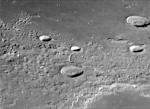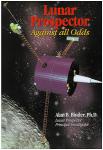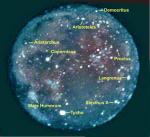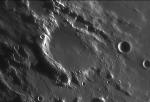|
 Two in a Row
Two in a Row
21.05.2005 | Lunnoe foto dnya
LPOD has never before published two images in a row from the same photographer - until now. Damian has returned from a very successful vacation/imaging session in the Caribbean and he is slowly processing and releasing a series of excellent images including some like todays and yesterdays of rarely seen limb craters.
 Rarely Seen Genius
Rarely Seen Genius
19.05.2005 | Lunnoe foto dnya
The eastern limb of the Moon is often imaged, perhaps because it is readily available in the early evening hours. But the western limb - which at sunrise is also visible at a convenient time, is much less commonly imaged, especially the areas north of Orientale.
 A Sharper Image
A Sharper Image
18.05.2005 | Lunnoe foto dnya
Does the Moon have corners? It has limbs, but it also seems to have out of the way areas that are infrequently observed. Often these are near very attractive areas that steal attention. Here is an often forgotten corner in the unnamed peninsula of grayness that seperates Imbrium from Frigoris.
 Against All Odds
Against All Odds
17.05.2005 | Lunnoe foto dnya
After the Apollo 17 crew returned to Earth on Dec. 17, 1972, the US sent no spacecraft to orbit the Moon until 1994 (Clementine) and 1998 (Lunar Prospector). Both of these were small, cheap missions flown because someone other than NASA wanted them.
![]() Procellarum Twins
Procellarum Twins
16.05.2005 | Lunnoe foto dnya
Western Oceanus Procellarum has few attractions because the relatively bland lava surface extends almost to the limb. But two nearly twin craters about 15 degrees north of the equator offer a number of observing challenges. Cardanus and Krafft are each about 50 km in diameter and each appears relatively fresh.
 Ancient Island
Ancient Island
14.05.2005 | Lunnoe foto dnya
Lunar maria are great piles of basaltic lava that were emplaced over hundreds of millions of years as thousands to perhaps millions of individual flows. Later flows often completely buried earlier ones, but sometimes an island of a higher elevation of an earlier flow remains, surrounded by younger lavas.
 Hotspots Identified!
Hotspots Identified!
13.05.2005 | Lunnoe foto dnya
LPOD for April 28 featured a red Moon created by the MSX satellite that imaged infrared radiation as the Moon cooled during an eclipse. My strong enhancement of the image revealed many hot spots that were probably due to bare rock surfaces inside the youngest craters on the Moon.
 Eclipse Stamp
Eclipse Stamp
12.05.2005 | Lunnoe foto dnya
Have you ever wished that the postal service would print stamps with pictures that interest you? In England and the USA (and other countries too?) you can now design your own stamps and use them as official postage. In England, the famous astronomy author and photographer Douglas Arnold has done just that.
 Imperial Image
Imperial Image
11.05.2005 | Lunnoe foto dnya
Lunar craters have not been named for political or religious leaders to avoid conflicts and confusion - imagine if there were different names for a Moslem Moon or a French Moon! But one history-making political leader does have a nomenclatural tombstone on the Moon.
 Theo as Youve Never See It
Theo as Youve Never See It
10.05.2005 | Lunnoe foto dnya
Theophilus is one of the lunar superstars - a magnificent crater that attracts the attention of observers and imagers. It is a complex crater like Copernicus, but slightly bigger (100 vs 93 km). Its terraces are not as well formed or as well preserved as those in Copernicus, but its central mountains are much bigger.

